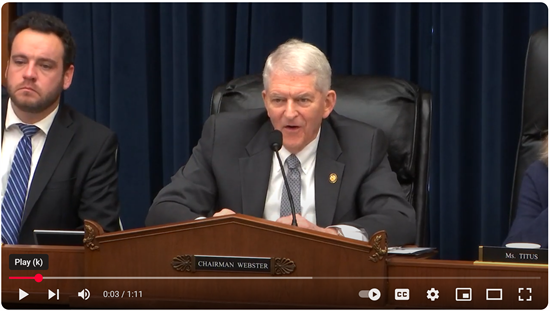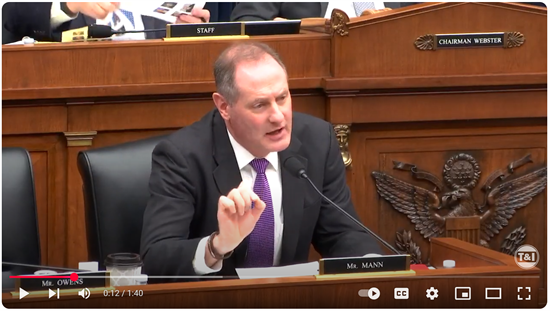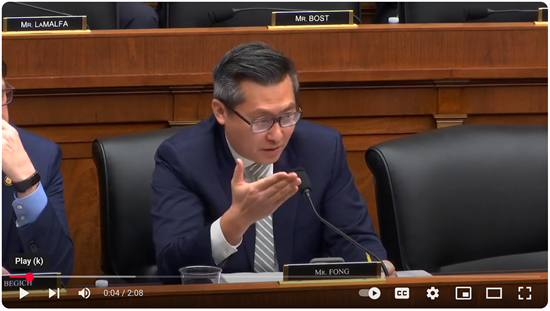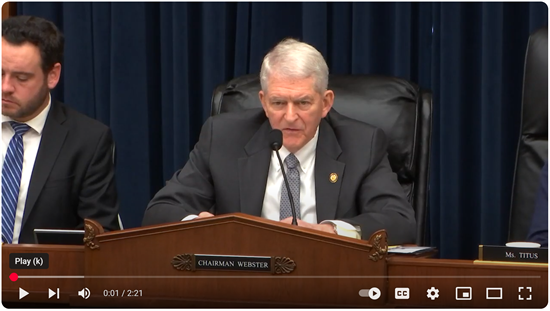Press Releases
Rail Stakeholders Support Streamlining Infrastructure Grant Programs and Project Approvals, Performance-Based Safety, and Competition at HearingWashington, DC – The Railroads, Pipelines, and Hazardous Materials Subcommittee heard testimony today from various railroad industry stakeholders about their priorities and suggestions for any potential surface transportation legislative proposals in the current Congress. Witnesses commonly highlighted support for programs that help build and improve the U.S. rail infrastructure network, such as federal programs to eliminate rail grade crossings and the Consolidated Rail Infrastructure and Safety Improvements (CRISI) Program. American Short Line and Regional Railroad Association President Chuck Baker noted the importance of the CRISI Program to short line railroads in particular, and he discussed the need to reduce the amount of red tape and delays involved in issuing grants and getting rail infrastructure built in general. Baker said, “Simply put, CRISI projects need to move from announcement to obligation to completion faster than they currently do. For almost all short line projects, most of which are quite simple in the context of infrastructure investments, this would result in better outcomes for the public, for short lines, for communities, and for shippers with no additional risk, and would help avoid the significant cost escalation associated with delay. Whether it be through batch processing of NEPA categorical exclusions, more aggressive use of pre-award authority to allow projects to get going immediately upon award, the blunt instrument of just setting deadlines for agency processing, or all of the above, Congress can and should insist that this process move faster.” Railroads, Pipelines, and Hazardous Materials Subcommittee Chairman Daniel Webster (R-FL) discussed permitting delays with Baker: National Railroad Construction & Maintenance Association Chairman Joe Daloisio concurred with the need to improve the efficiency of CRISI and other grant programs. He testified, “the speed at which grant agreements have been executed has been way too slow. By the time the construction phase begins, a number of variables, most notably the increase in costs, jeopardizes the successful execution of these important projects. We encourage Congress and the new Administration to deliver grant funding in a responsible but more expedient manner.” Association of American Railroads President and Chief Executive Officer Ian Jefferies also addressed the need for permitting reforms: “While efforts to cut red tape associated with infrastructure project approval and construction have borne some fruit in recent years, more can still be done to fast-track routine rail construction projects without ignoring environmental or historical preservation concerns. For example, policymakers could codify that, for rail projects whose purpose is to replace existing infrastructure on existing operating railroad right-of-way, a categorical exclusion and a finding of no significant impact are the only NEPA documentations necessary. In addition, policymakers could convert to statute select executive orders on streamlining the permitting process, such as timeclocks, intermediate deadlines, and One Decision.” Rep. Tracey Mann (R-KS) asked Jefferies to elaborate further about targeted changes Congress can make to improve the movement of people, goods, and products by rail: Rep. Vince Fong (R-CA) and witnesses also discussed changes and reforms that can help optimize and expand freight rail infrastructure to accommodate increased demand in the supply chain: Witnesses also urged Congress to avoid moving towards reregulation or imposing overly prescriptive mandates on the industry. Panelists highlighted the need to maintain railroads’ ability to utilize technological advancements to improve safety, as well as the need for any safety regulations to be based on science and data. “The further use of emerging technologies to enhance rail safety and operations, however, will be needlessly stunted if regulators at the FRA and elsewhere in DOT fail to embrace technological change, or if they lock in existing technologies and processes so that new innovations and new technologies that could improve safety and improve efficiency are stifled,” said Jefferies. Daloisio said, “It is imperative to allow railroads and rail contractors and suppliers to innovate and deploy safety technologies. We urge Congress to use data-driven solutions that would effectively increase the safety of the rail network and avoid policy changes that would place unnecessary or excessive mandates on the rail industry that would not enhance rail safety.” Chairman Webster asked witnesses to provide their thoughts on performance-based approach to safety regulations:Daloisio also stressed the importance of a competitive bidding process in rail construction and maintenance contracts in order to get the best return on these investments: “The NRC strongly supports increased opportunities for contracting out and competition within these programs to stretch federal funds further. Increased flexibility for railroads and commuter rail agencies to contract out work will benefit the industry. This is not an attempt to take work from in-house labor forces, rather it is intended to help the industry as a whole perform more work more efficiently. Often times our members are able to find the most innovative ideas and methods to deliver projects for less cost without compromising safety. Our member companies are both specialized in and incentivized to accomplish this on a daily basis. Therefore, we would like to strongly urge that all rail construction and maintenance work performed with federal assistance be competitively bid out to the independent railroad construction industry, to the fullest extent possible, to ensure the most efficient use of taxpayer dollars.” Click here for more information from today’s hearing. |










